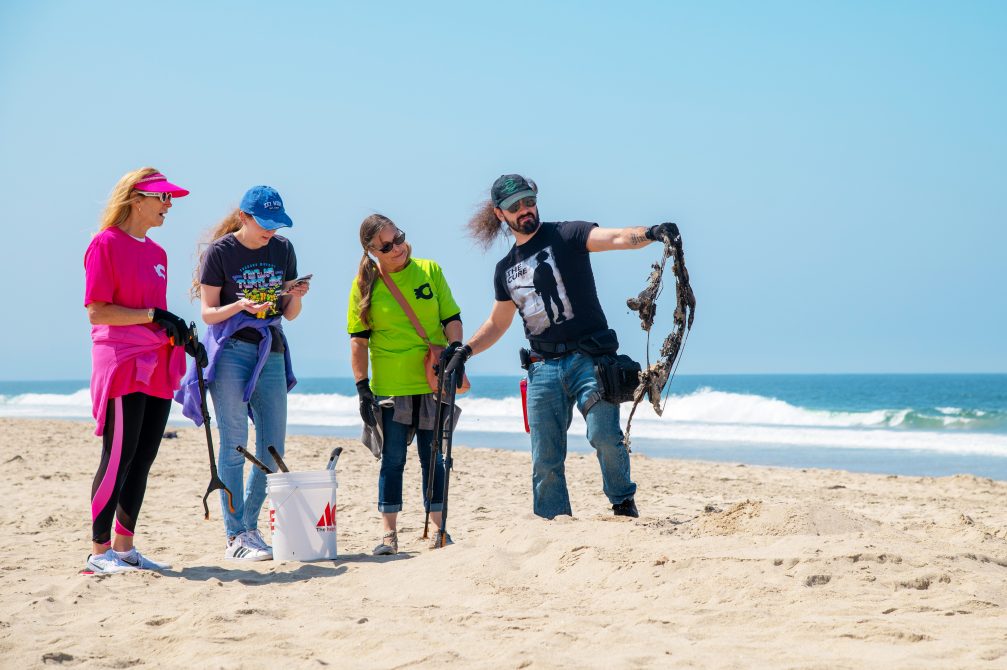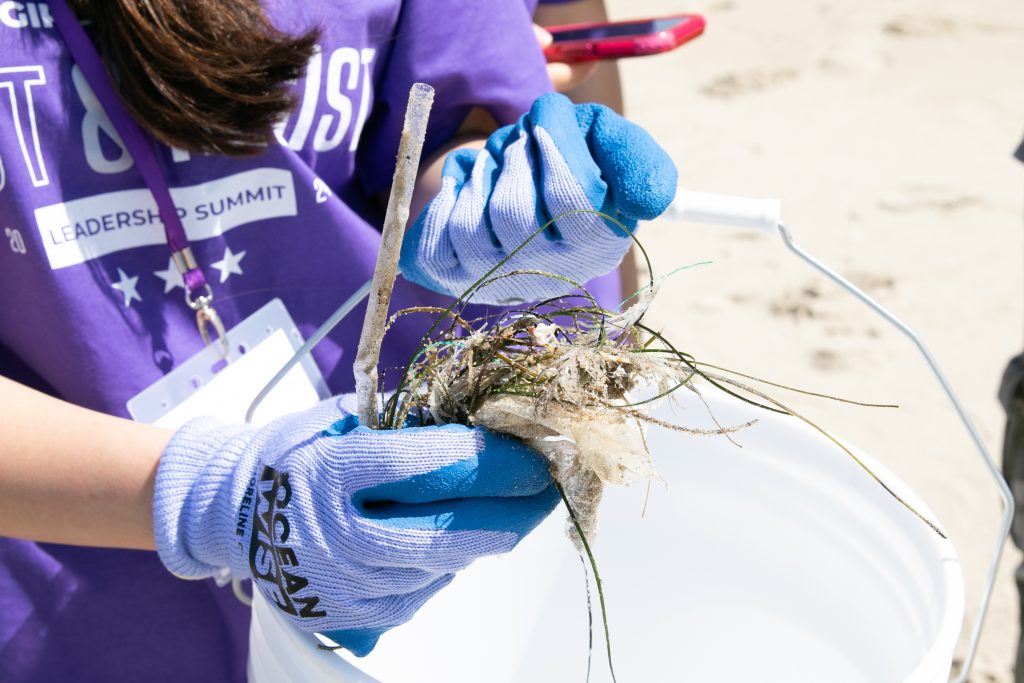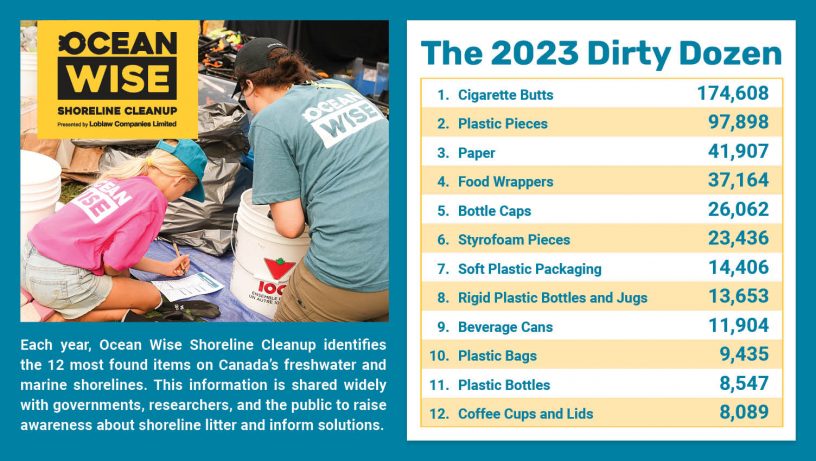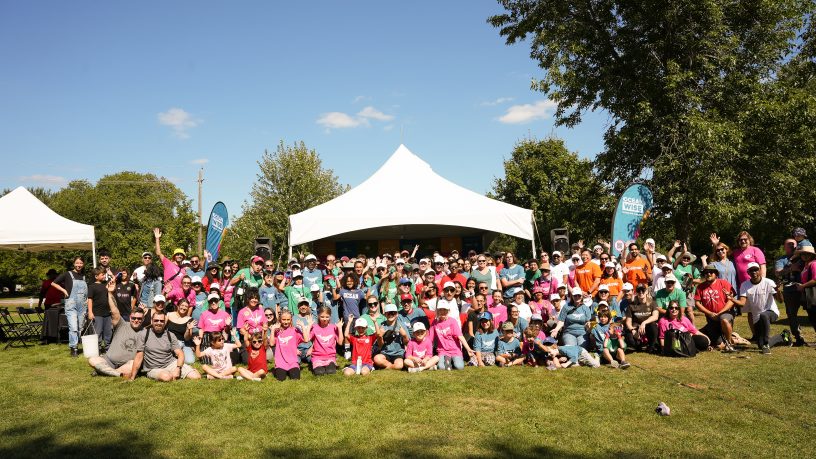
Harnessing Citizen Science: How Litter Data from Ocean Wise Drives Policy, Research and Community Action
Participating in an Ocean Wise Shoreline Cleanup is an opportunity to make a tangible difference to keep litter out of our waterways. But the impact goes way deeper! At the heart of the Shoreline Cleanup program is the data that citizen scientists collect during cleanups. This data, showcased in our Annual Impact Reports and Dirty Dozen lists, goes far beyond our organization. Researchers use it to study environmental health, governments to develop evidence-based policies, and local communities to advocate for sustainability. For the 30 years our Shoreline Cleanups have taken place, the efforts of thousands of citizen scientists have turned this data into a powerful tool for researchers, policymakers, and curious minds. Let’s dive into some of the impactful ways our data has been used!
Data-Informed Policy
Data collected by citizen scientists allows the identification of trends and problematic items and lays the groundwork for influencing policy changes across Canada.
Canada’s Single-Use Plastics Ban
Shoreline Cleanup data informed Canada’s single-use plastics ban, a step that placed Canada among global leaders in the fight against plastic pollution. Authored by Environment and Climate Change Canada and Health Canada in 2020, the Science Assessment of Plastic Pollution cited Shoreline Cleanup data throughout to illustrate the types and prevalence of plastic litter found on shorelines. The report took particular note of our annual Dirty Dozen list to highlight some of the worst offenders on Canada’s shorelines. This review informed the federal government’s single-use plastics ban that includes several longstanding Dirty Dozen items including plastic bags and straws. Here at Ocean Wise, we’re now using our Shoreline Cleanup data to monitor the impact of the federal plastics ban and have recently seen some promising indicators! In 2023, for the first time in a decade, straws were not included in the Dirty Dozen list. Read our annual impact report here!
City of Vancouver Single-Use Item Reduction Strategy
The City of Vancouver’s zero-waste strategy is using Shoreline Cleanup data as a monitoring and verification tool. Paving the path towards a zero-waste future, the City of Vancouver developed a strategy in 2018 to phase out single-use items such as plastic and paper bags, polystyrene foam containers, disposable drink cups, take-out food containers, and single-use utensils (recognize any of these from our Dirty Dozen?). The strategy uses Shoreline Cleanup data to measure the city’s progress and monitor how litter changes over time.

Data-Informed Research
From assessing the litter composition on shorelines to conservation plans for specific species, Shoreline Cleanup data has been used in many research papers in Canada.
An Assessment of Shoreline Litter by the University of British Columbia
Not in my backyard…or is it? Shoreline Cleanup data was by used by Konecny et al. (2018) at the University of British Columbia to compare the type and quantity of litter found along coastlines in British Columbia. Their team found that isolated and wave-exposed shorelines had more trash per kilometer compared to other areas, and that between 80 and 90 percent of litter items were made of plastic. This paper recommends that cleanups be combined with regulatory changes at local and global scales, awareness campaigns and waste management infrastructure to reduce the leak of litter into the ocean.
Evaluating Canada’s Single-Use Plastic Reduction Strategies
We’ve seen how Shoreline Cleanup data can be used to inform policy decisions, but it can also be used to evaluate them! A graduate project by Baxter (2021) evaluated the effectiveness of Canada’s single-use plastic mitigation strategies, including the extended producer responsibility (EPR) and deposit-return programs, single-use plastic bans, and outreach campaigns. By conducting a brand audit and using Shoreline Cleanup data in multiple locations, Baxter identified common brands found in these areas. Stronger mitigation strategies, including a global treaty, are recommended to reduce marine plastics. Through the Shoreline Champions Program and Plastic Reduction Program, we’re working with businesses and brands of all types to support them on their plastic reduction journey.
A Comparison of Shoreline Litter and Double-Crested Cormorant Nests
Litter can pose a threat to animals, from entanglement to ingestion, and understanding this impact is important for conservation. Double-crested cormorant birds have been used as an indicator species – a species that helps provide information on the state of ecosystem health. In this case, Damian & Fraser (2020) studied a double-crested cormorant nest in Toronto, Ontario to compare the litter found in the nests with litter found at a site on the Great Lakes from a Shoreline Cleanup. Plastic was the most common item found in the nests and in Shoreline Cleanup data, but the nests featured more construction materials from a nearby site. This study highlights the need to monitor changes in debris type and quantity to protect inland environments and the welfare of waterbirds.

Data for School Projects
Research and policy are not the only ways that Shoreline Cleanup data can be used! We receive requests for our data for projects from elementary school to PhD levels. One interesting example comes from Lethbridge Polytechnic (formerly Lethbridge College) and the Helen Schuler Nature Centre, which used data collected during annual cleanup events for an end-of-term project. The students mapped out litter data in Lethbridge to assess the effect it had on ecosystems, including on waterways, plants, and animals. Check out the great work the students put together here.
For more examples on how Shoreline Cleanup data has been used, check out:
- What We Heard on Marine Debris in B.C. outlines problems and solutions for marine debris in BC.
- Blais (2020) assessed possible pathways of exposure and impacts of plastic debris on the endangered Northwest Atlantic Leatherback population in the Maritimes in this thesis project.
- Another thesis project by Driedger (2015) classified debris in the Great Lakes and found that more than 80 percent was made of plastic!
- At the Memorial University of Newfoundland, a study by Harris et al. (2021) evaluated the effectiveness of an extended producer responsibility (EPR) policy related to plastic packaging in BC.
How Can You Help?
- Learn more about how you can contribute to our Shoreline Cleanup litter dataset by joining or leading a cleanup in your community! This is a fantastic way to add information to our dataset, especially for participants based in the United States as we grow our litter base in new regions.
- Do you have an idea or project that could benefit from Shoreline Cleanup litter data? Learn more about requesting our data!
None of this would be possible without our dedicated citizen science volunteers. Armed with trash bags and an unwavering commitment to keeping our shorelines clean, your efforts have built our litter database into what it is now. Our data is open source and available by request to support anything from school projects to scientific articles.
Now we want to turn it over to you – how can you use our data to make a difference in your community?
Posted August 30, 2024 by Cayley Elcombe


